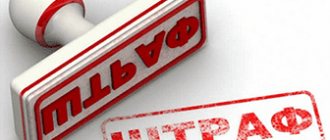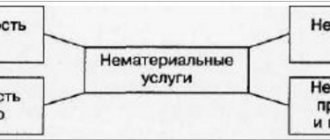An estimated liability (OO) is an existing obligation of a company, the fulfillment of which will inevitably occur, while its value or deadline is characterized by uncertainty. Recognition of an estimated liability, and in reality it is called the formation of a reserve, is the recognition of costs. According to accounting rules, all expenses (actual and potential) must be reflected in the statements, otherwise it is impossible to achieve a real picture of the amount of net profit - the profit will be overstated, and users will not receive true information about the actual state of affairs in the company.
Regulates the obligation to recognize PAs in accounting PBU 8/2010; in tax accounting, reserves are not formed for them.
Encyclopedia of solutions. Other liabilities (line 1550)
Other liabilities (line 1550)
On line 1550 of the balance sheet, enter the amounts of short-term liabilities whose repayment period does not exceed 12 months, which are not reflected in lines 1510-1540 of the form. These are those obligations that, first of all, are not significant (paragraph 2 of clause 11 of PBU 4/99 “Accounting statements of an organization”, letter of the Ministry of Finance of Russia dated January 24, 2011 N 07-02-18/01).
When filling out line 1550, information about credit balances on the following accounts is used:
— account 86 “Targeted financing in terms of targeted budget financing funds not spent as of December 31 of the reporting year and reflected on the loan (provided that such funds are not reflected in the balance sheet under the item “Deferred income” (line 1530)) ( clause 20 PBU 13/2000 “Accounting for state aid”);
— account 76 “Settlements with various debtors and creditors” in terms of amounts:
1) claims brought against the organization by counterparties for violation of the terms of business contracts and recognized by it as of December 31 of the reporting year;
2) deposited wages not received by the organization’s personnel as of December 31 of the reporting year;
3) VAT accepted for deduction when transferring an advance (prepayment) and subject to recovery upon receipt of goods, works, services or upon return of a previously transferred advance;
— account 71 “Settlements with accountable persons” in terms of debt to accountable persons not repaid as of December 31 of the reporting year.
Details of the amounts of short-term accounts payable should also be given in the explanations to the balance sheet, in table 5.3 “Presence and movement of accounts payable.” If budget financing funds are taken into account as part of short-term accounts payable, data on them is additionally provided in Table 9 “State Aid” of the explanations to the balance sheet.
Example of filling out line 1430 “Estimated liabilities”
Let's look at a clear example of what the completed line 1430 “Estimated Liabilities” will look like:
Solution to the problem of filling line 1430:
Short-term liabilities. P2. Balance lines
Hello, Vasily Zhdanov is here, in this article we will look at short-term liabilities. Liabilities are usually called all financial sources from which the company receives funds. They are displayed in the account. balance sheet, the current form (OKUD 0710001) which was introduced by Order of the Ministry of Finance of the Russian Federation No. 66n dated July 2, 2010, as amended. with change from 2021. According to this form, liabilities include: capital, reserves, as well as long-term and short-term liabilities.
The last two liabilities may have another name, close to the one indicated, namely: long-term and short-term liabilities. The essence does not change from this. But in practice, you can equally often find both the first and second variants of their name.
Another nuance that should be noted is the identification of the two terms “liabilities” and “liabilities” in terms of borrowed capital. In fact, they are synonymous and also often appear in economic theory and practice.
Liabilities are classified according to different criteria. For example: by ownership (its own or borrowed capital), depending on who the company owes (wages, contractors), etc. The classification of liabilities most often used in practice is based on the urgency of their repayment.
| Liability group | Line-by-line distribution in the account. balance sheet | Examples |
| P1 (most urgent obligations) | Page 1520 | These obligations should be covered first, such as accounts payable, which are repaid within no more than 3 months. |
| P2 (short-term or short-term) | Page 1500 | The repayment period for these obligations cannot exceed a year. These are: debts to suppliers, wage arrears |
| P3 (long-term) | Page 1400 | Debts can be repaid within a period exceeding 12 months. The main types of such obligations are long-term loans with credits |
| P4 (permanent) | Page 1300 + 1530 + 12605 | They are not obligations and do not involve external payment. This includes your own and long-term borrowed capital. |
Liabilities grouped in this way are used in the financial analysis of the enterprise. In particular, when studying the liquidity of accounting. balance sheet, as well as to determine the financial solvency of the enterprise.
Comparison of groups of assets and liabilities: division of assets, current standards and their meanings
When assessing the liquidity of an enterprise, it is customary to compare groups of liabilities and assets. Before moving on to this issue, you should take into account some important factors accompanying the division of assets and liabilities into groups.
The division of liabilities has already been described above. As for assets, they, like liabilities, can be divided into 4 groups: A1 (the most liquid), A2 (quickly liquid). A3 (slowly liquid) and, accordingly, A4 (slowly liquid).
Among other features of this classification of assets, the use of different names for the same groups should also be separately noted. They can be consonant, synonymous, or not differ significantly, but in practice they still designate the same group and do not change their purpose.
For example, the most liquid assets from gr. A1 can be called the most liquid, and, for example, quickly liquid assets from gr. A2 – urgently liquid or quickly marketable. In fact, this phenomenon occurs very often in practice during analysis. Therefore, you just need to know and take this point into account so as not to be misled due to some difference in the name of one or another group of assets (liabilities).
Important! When assessing the liquidity of an enterprise, all groups of assets and liabilities should be compared, and not just one of the groups.
Thus, they compare: A1 with P1, A2 with P2, A3 with P3, A4 with P4. It is appropriate to make such comparisons for any period (for a month, a quarter, a year, two years, etc.). That is, essentially, if necessary. Comparisons over several periods are considered the most effective, since this allows you to track ongoing changes in dynamics. Based on the results of such comparisons, the overall liquidity indicator of the book is derived. balance sheet and determine the level of financial viability of the enterprise as a whole.
The following ratios are recognized as standard: A1>P1, A2>P2, A3>P3, A4 < or = P4. The ideal option is to meet all three standards. Then they “automatically” imply compliance with the third relationship: A4 < or = P4, and b. the balance is recognized as absolutely liquid. But in practice, such an “ideal” option does not occur very often.
A direct comparison of quickly liquid assets and short-term liabilities, subject to the ratio A2>P2, will mean the following:
- The company is able to pay off debt obligations using quickly liquid assets.
- Repayment of these debts is possible in the near future (relatively speaking, in the short and medium term).
It should be taken into account that if, after a comprehensive comparison of assets and liabilities, it turns out that A4>P4, then the enterprise can be called illiquid.
Current liabilities in accounting. balance sheet: composition, line-by-line distribution
So, short-term liabilities are those obligations that are repaid in a period of no more than a year. In the form of an updated balance sheet, they are reflected in Section V. The composition of this section and the line-by-line distribution of liabilities is as follows.
| Borrowed funds | Creditor. debt | Future income periods | Estimated liabilities | Other obligations | Summary of Section V |
| Page 1510 | Page 1520 | Page 1530 | Page 1540 | Page 1550 | Page 1500 |
The total for the entire section (line 1500) or the sum of all completed lines of this section minus line 1520 (accounts payable) is the value of P2 (short-term liabilities). In other words:
When calculating, a question may arise as to where to include future income. Despite the fact that they are formed at the current moment, and the obligations under them are in the short term, they last more than 2 years. That is, we are talking about future income. In this regard, it is assumed that such future income is usually equal to zero, so it does not matter where they are taken into account. Meanwhile, in many services that provide financial analysis services, they are taken into account in long-term liabilities.
Taking into account the above, the above formula may be modified. The calculation can also be done like this:
Another option for calculating P2, in addition to the above lines, includes one more:
Formula 2 is considered the most optimal calculation option. What is important is that there is no separate standard for P2. But it is recognized that a decrease in this indicator is a positive factor.
When do estimated liabilities arise?
Such obligations may arise as a result of court decisions, obviously unprofitable contracts, as a result of the company’s actions, when confidence is created that it will fulfill its promises. For example, the upcoming closure of a company branch may lead to an increase in the cost of paying severance benefits to staff or the termination of contracts for which a penalty will have to be paid. At the same time, in order to form a reserve for the costs of restructuring production, the following conditions must be met:
- there is an action plan that determines the approximate amount of costs;
- management began implementing this plan - for example, notices of upcoming dismissal were sent to employees, letters of termination of cooperation to contractors.
If the company becomes aware of the unprofitability of the concluded contract, and termination threatens to impose an impressive fine, then the estimated liability is recognized in the smallest amount - the loss from the execution of the contract or the fine upon its termination. A reserve is created in the month when the unprofitability of the agreement is established.
Example
The company has entered into an agreement for the supply of its products. Estimated revenue – 2000 thousand rubles. In connection with the changed market situation (increasing prices for raw materials), the company carried out an assessment, the result of which was the conclusion: the cost of manufactured products will be 2,500 thousand rubles. Execution of the terms of the agreement has not begun. The penalty for unilateral termination is indicated in the amount of 700 thousand rubles.
Such an agreement is considered obviously unprofitable, since the costs of its implementation will exceed the planned income, and for the termination of the contractual relationship the company is obliged to pay 700 thousand rubles.
Since losses in this situation are inevitable, the estimated liability will be recognized in the company’s accounting in the amount of the smaller loss - 500 thousand rubles. when fulfilling the contract (2500 - 2000), since the amount of the penalty for termination is 700 thousand rubles.
Some features of entering data into Section V of the account. balance
Passive buh. The balance sheet is presented in two sections: “Long-term liabilities” (Section IV) and “Short-term liabilities” (Section V). According to the last, fifth section, it is necessary to display information about short-term financial sources attracted by the enterprise. It is recommended to take into account the following features of filling out lines:
- on page 1510, register data using the account. 66 and partially 67 (settlements for short-term and long-term loans, credits);
- on page 1520 indicate the generalized amount of all types of short-term debt (data for accounts 60, 62, 68, 69, 70, 71, 73, 75, 76).
- line 1530 is completed if this accounting object is recognized in accordance with accounting provisions;
- on page 1540 show credit. account balance 96;
- page 1550 is intended to display those types of short-term liabilities that were not included in the previous lines mentioned above;
- page 1500 reproduces the total for all previous lines 1510–1550.
Thus, the total amount of short-term borrowed capital of the enterprise is the result according to section. V, i.e. page 1500. When forming the book. balance sheet and, in particular, section. V, one should also take into account the fact that enterprises autonomously detail the indicators for the relevant items of the generated reports. This right is reserved for all organizations and is justified. So, for example, an enterprise has the right to supplement p. 1520 in section. V in the appropriate lines, detailing, deciphering in this way, this or that indicator.
An example of calculating the amount of an estimated liability
Svet LLC received a subpoena in 2021. The defendant in the case is LLC “Darkness”, whose demands are to forcefully collect from the plaintiff direct costs in the amount of 15,000 rubles and lost profits in the amount of 55,000 rubles.
The trial continued when the end of the reporting period came for Svet LLC. An internal expert of the enterprise believes that Tma LLC will win in court. Moreover, if, according to a court decision, the plaintiff undertakes to compensate only the direct costs of the opponent, the losses will amount to only 15 thousand rubles. But if Svet LLC also has to compensate for lost profits, the expense will be equal to 70 thousand rubles. The consulting services of an external expert were paid, who issued an opinion on the likelihood of a court decision: 70% to 30%, respectively.
There is such a scenario that Svet LLC, by court decision, will have to compensate only the direct costs of Darkness LLC and spend only 15 thousand rubles to pay off the obligation. However, the calculation of the amount of estimated liabilities in the plaintiff’s accounting is carried out taking into account the likelihood of compensation also for lost profits of T’ma LLC:
15,000 rub. x 0.7 + 55,000 rub. x 0.3 = 27,000 rubles.
The estimated repayment period for the estimated liability is six months. It will be recorded by the accountant of Svet LLC in the amount of 27 thousand rubles in account 96.
Short-term liabilities P2 in formulas for calculating liquidity indicators
Liabilities from group P2 are used in calculating a number of liquidity ratios. In particular, when calculating KTL, KSL, KAL. These are the main ratios of current, urgent and, accordingly, absolute liquidity. Each of them has a specific purpose.
For example, CTL (current ratio), the most famous and often used in financial analysis. It is calculated as follows:
In the said formula there is a group of short-term liabilities P2, as well as P1, A1, A2 and A3. That is, by itself, separately, the P2 indicator indicated in formula 4 is not analyzed, but only participates in the calculation. But without it, calculation and analysis of the KTL value is not possible.
If, based on the calculation results, KTL = 1.5–2, then this will mean compliance with the norm. A KTL value that is less than 1 indicates the enterprise’s inability to pay current obligations on time. There is a destabilization of the financial situation, which, according to the logic of events, implies the presence of significant financial risks for the enterprise.
The remaining liquidity ratios are calculated and analyzed in a similar way. For comparison, the calculation of the CLR (urgent, critical or quick liquidity ratio) is considered below. Using it, you can find out the ability of a particular enterprise to pay current obligations in a difficult financial situation using A1 and A2. Formula for calculating KSL:
This formula uses A1, A2 and P1, P2. That is, there is more than one P2 indicator. The result of calculation with his participation in the situation under consideration must be at least 0.7. If the value of the CFL is less than this minimum, then we can talk about a drop in the solvency of the enterprise. The best result is considered to be a value of KSL = from 0.8 to 1.2.
Short-term liabilities
Short-term liabilities are obligations that are covered by current assets or repaid as a result of the formation of new short-term liabilities.
The analysis of short-term liabilities is carried out in the FinEkAnalysis program in the block Analysis of financial condition in dynamics.
Short-term liabilities are usually repaid over a short period (no more than one year). Isolating short-term liabilities into a separate group is important for monitoring balance sheet liquidity.
Short-term liabilities in the balance sheet are section V “Short-term liabilities”. Current liabilities include:
- short-term loans;
- current debt on long-term liabilities;
- short-term bills issued;
- debt to suppliers and contractors;
- debt on taxes and fees;
- debt to personnel;
- revenue of the future periods;
- reserves for future expenses;
- other short-term liabilities.
Further:
- long-term liabilities
- liabilities,
- balance sheet liability,
- current liabilities,
- stable liabilities,
- permanent liabilities.
Synonyms
Short-term liabilities
Was the page helpful?
Frequently asked questions on the topic “Provisions (line 1430)
Question: What regulatory act regulates the acceptance of estimated liabilities in accounting, their write-off, the calculation of their amount and the display of information about them in the balance sheet of the enterprise?
Answer: PBU 8/2010 (approved by Order of the Ministry of Finance of the Russian Federation dated December 30, 2010 No. 167n).
Question: Is there a standard indicator of estimated liabilities? What does a decrease or increase in a standard indicator mean?
Answer: No normative or legislative acts have established standard values for the indicator of estimated liabilities, therefore there is no economic interpretation of its values. However, we can definitely say that an increase in the amount of estimated liabilities over time indicates a decline in the efficiency of the enterprise.
More found about short-term liabilities
- Financial analysis of an enterprise - part 2 Calculated as the ratio of the amount of current assets of working capital to current liabilities and short-term obligations of the enterprise. It is believed that this ratio should be within the range of 1.0 2.0, t
- Financial analysis of an enterprise - part 4 The absolute liquidity ratio is equal to the ratio of the value of the most liquid assets to the amount of the most urgent liabilities and short-term liabilities Kl a 2002 73.7 0.001 54866 Kl a 2003 7546 0.036 209568 Kl
- Assessment of the financial stability of the organization according to the annual financial statements of the KSP short-term liabilities, i.e. short-term loans and credits, as well as other short-term liabilities Payment ratio of long-term ones
- Conceptual approach to analyzing the state and dynamics of an organization’s financial resources Long-term liabilities Short-term liabilities The structure of assets and liabilities depends on the amount of equity and borrowed funds and
- Analysis of balance sheet liquidity Balance sheet liabilities are grouped according to the degree of urgency of their payment most urgent liabilities accounts payable and loans not repaid on time short-term liabilities short-term loans and borrowed funds long-term liabilities long-term loans and borrowed funds permanent liabilities
- Methodical approach to solvency analysis In all these transformations, we have neglected two amounts of balance sheet liabilities - long-term liabilities and short-term liabilities not related to short-term debt. These amounts can often be neglected for the reason
- Theoretical and practical aspects of assessing the liquidity of an enterprise P2 Short-term liabilities are short-term borrowed funds, debt to participants for the payment of income, other short-term liabilities
- Features of the liquidity audit of the balance sheet of commercial organizations P2 short-term liabilities short-term loans and borrowings from 610 PZ long-term liabilities long-term loans and borrowings from
- Assessment of the risk of changes in current liquidity in the processes of restructuring industrial enterprises using outsourcing of goods and materials TP current liabilities short-term liabilities attributable to accepted functions As a note, we note that short-term financial investments
- A matrix balance sheet will help control the solvency of the company Accounts payable and other short-term liabilities 6200 48 200 Short-term financial investments 250 0 0
- Working capital management policy in the holding The current liquidity ratio of 2.5 in 2009 was calculated taking into account the forecasted need for short-term liabilities, which, subject to choosing a compromise model for financing current assets, will amount to 2.4 billion rubles
- Analysis of the balance sheet in accounting services for small businesses Long-term liabilities 590 9259 8252 -1007 6 4.5 -1.5 -10.8 -3.4 5 Short-term liabilities 5.1 Borrowed funds 610 19163 10849 -8314 12.5 6 -6.5 -43.3 -28.6 5.2
- Comparative analysis of Russian and foreign approaches to analyzing the financial condition of an organization P1 accounts payable short-term liabilities P2 short-term credits and borrowings and other short-term liabilities long-term liabilities PP long-term liabilities
- Statistical analysis of the relationship between capital management indicators and the market value of public companies in Russia. Company debt ratio, the share of long-term and short-term liabilities in balance sheet currency in the period 2000-2008 ranged from 0.284 in 2001 to
- Current issues and modern experience in analyzing the financial condition of organizations - part 4 P2 short-term liabilities short-term borrowed funds debt to participants for payment of income other short-term liabilities P3 long-term liabilities
- Financial stability of organizations of the military-industrial complex with a long production cycle O KO KZD 12 Thus, the condition for ensuring normal financial stability has been reduced to inequality 12 at each point in time, cash short-term financial investments and receivables must cover long-term liabilities short-term bank loans and accounts payable Similar calculations lead to the following inequalities characterizing the rest
- Analysis of financial statements. Practical analysis based on accounting (financial) statements LIABILITIES Borrowed funds 7266 7.65 5787 5.37 -2.28 Short-term liabilities P1 1884 1.98 1647 1.53 -045 Current accounts payable 1884 1.98 1647 1.53
- Matrix in working capital management If the amount of current assets exceeds the amount of short-term liabilities by three or more times, then such a picture may indicate an unbalanced structure
- Type of financial stability Long-term liabilities Short-term loans and borrowings Unstable financial situation manifests itself in the form of violations of financial discipline and delays
- Analysis of the structure of the monetary capital of an economic entity: problems of formation and ways of optimization (using the example of JSC Uralkhimmash) When managing monetary capital, investment needs should be financed with own funds and long-term borrowed liabilities, and short-term borrowed resources should be directed to maintaining operating activities In terms of financing non-current assets
Short-term liabilities
Short-term liabilities are those whose maturity does not exceed 12 months after the reporting date.
Short-term liabilities include short-term accounts payable of the organization to suppliers (for goods supplied, work performed and services provided for the organization), buyers (for advances received from them), founders and employees, to the budget and extra-budgetary funds, lenders and other creditors.
In addition, reserves for future expenses are reflected as part of the organization's short-term liabilities.
Common entries for accounting for cash reserves
The most common accounting entries for reserve finance, including the repayment of estimated debts, are presented in the following table:
| Operation | DEBIT | CREDIT |
| Creating a cash reserve | ||
| Formation of a cash reserve for the purpose of paying vacation pay to employees, including for the purpose of paying insurance premiums for compulsory insurance. | 20 (23, 25, 44) | 96 |
| Formation of a cash reserve against the company's upcoming expenses | 91 | 96 |
| Write-off of cash reserves | ||
| Accrual of insurance payments from cash reserves | 96 | 70 |
| Calculation of insurance premiums at the expense of estimated liabilities | 96 | 69 |
| Repayment of expenses for auxiliary production and current repairs | 96 | 23 |
| Making adjustments and accounting for excessively accrued cash reserve amounts as other expenses | 96 | 91.1 |
Current liabilities and balance sheet
In the form of the Balance Sheet, approved by Order of the Ministry of Finance of Russia dated July 2, 2010 N 66n, section. V looks like this.
| Explanations | Indicator name | Code | On ____ 20__ | As of December 31, 20__ | As of December 31, 20__ |
| V. SHORT-TERM LIABILITIES | |||||
| Borrowed funds | |||||
| Accounts payable | |||||
| revenue of the future periods | |||||
| Estimated liabilities | |||||
| Other obligations | |||||
| Total for Section V | |||||
| BALANCE |
This section displays information about the organization's short-term liabilities.
Account 96 of the balance sheet: general information
Account 96 of accounting is intended to record information on the creation of reserve funds intended to fulfill the company’s existing obligations. In this case, the accountant evenly assigns funds from reserves to expenses.
96 account – active-passive. The debit will display the actual expenditure of the funds that formed the reserve. And for the loan, the reservation of the calculated amounts in correspondence with the accounts is demonstrated:
- expenses for sales of goods/services;
- accounting for production costs.






